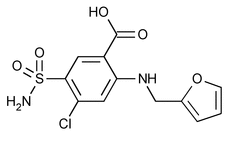Furosemide
(fure oh' se mide).
Benzoic acid, 5-(aminosulfonyl)-4-chloro-2-[(2-furanylmethyl) amino]-.
4-Chloro-N-furfuryl-5-sulfamoylanthranilic acid
» Furosemide contains not less than 98.0 percent and not more than 101.0 percent of C12H11ClN2O5S, calculated on the dried basis.
Packaging and storage—
Preserve in well-closed, light-resistant containers. Store at 25 , excursions permitted between 15
, excursions permitted between 15 and 30
and 30 .
.
USP Reference standards  11
11 —
—
Identification—
B: Ultraviolet Absorption  197U
197U —
—
Solution:
8 µg per mL.
Medium:
0.02 N sodium hydroxide.
Absorptivities at 271 nm, calculated on the dried basis, do not differ by more than 3.0%.
C:
Dissolve about 5 mg in 10 mL of methanol. Transfer 1 mL of this solution to a flask, add 10 mL of 2.5 N hydrochloric acid, and reflux on a steam bath for 15 minutes. Cool, and add 15 mL of 1 N sodium hydroxide and 5 mL of sodium nitrite solution (1 in 1000). Allow the mixture to stand for 3 minutes, add 5 mL of ammonium sulfamate solution (1 in 200), mix, and add 5 mL of freshly prepared N-(1-naphthyl)ethylenediamine dihydrochloride solution (1 in 1000): a red to red-violet color is produced.
Loss on drying  731
731 —
Dry it at 105
—
Dry it at 105 for 3 hours: it loses not more than 1.0% of its weight.
for 3 hours: it loses not more than 1.0% of its weight.
Residue on ignition  281
281 :
not more than 0.1%.
:
not more than 0.1%.
Heavy metals, Method II  231
231 :
0.002%.
:
0.002%.
Related compounds—
[note—Protect Furosemide solutions from exposure to light. ]
Mobile phase—
Prepare a filtered and degassed mixture of water, tetrahydrofuran, and glacial acetic acid (70:30:1). Make adjustments if necessary (see System Suitability under Chromatography  621
621 ).
).
Diluting solution—
Dilute 22 mL of glacial acetic acid with a mixture of acetonitrile and water (50:50) to 1000 mL, and mix.
System suitability solution—
Dissolve suitable quantities of USP Furosemide RS and USP Furosemide Related Compound A RS in Diluting solution to obtain a solution containing about 20 µg per mL and 12 µg per mL, respectively.
Standard solution—
Prepare a solution in Diluting solution containing 5.0 µg each of USP Furosemide Related Compound A RS and USP Furosemide Related Compound B RS per mL.
Test solution—
Transfer an accurately weighed quantity of Furosemide to a suitable volumetric flask, dissolve in and dilute with Diluting solution to volume to obtain a solution having a concentration of about 1.0 mg per mL, and mix.
Chromatographic system (see Chromatography  621
621 )—
The liquid chromatograph is equipped with a detector capable of recording at both 254 nm and 272 nm and a 4.6-mm × 25-cm column that contains packing L1. [note—The 2,4-dichloro-5-sulfamoylbenzoic acid impurity does not respond at 272 nm and the 2,4-bis(furfurylamino)-5-sulfamoylbenzoic acid impurity has a very intense absorbance at 254 nm. ] The flow rate is about 1.0 mL per minute. Chromatograph the System suitability solution, and record the peak responses as directed for Procedure: the resolution, R, between furosemide and furosemide related compound A is not less than 2.5; and the relative standard deviation determined from furosemide is not more than 2.0%. [note—The response for furosemide is at 254 nm. ]
)—
The liquid chromatograph is equipped with a detector capable of recording at both 254 nm and 272 nm and a 4.6-mm × 25-cm column that contains packing L1. [note—The 2,4-dichloro-5-sulfamoylbenzoic acid impurity does not respond at 272 nm and the 2,4-bis(furfurylamino)-5-sulfamoylbenzoic acid impurity has a very intense absorbance at 254 nm. ] The flow rate is about 1.0 mL per minute. Chromatograph the System suitability solution, and record the peak responses as directed for Procedure: the resolution, R, between furosemide and furosemide related compound A is not less than 2.5; and the relative standard deviation determined from furosemide is not more than 2.0%. [note—The response for furosemide is at 254 nm. ]
Procedure—
Separately inject equal volumes (about 20 µL) of the Standard solution and the Test solution into the chromatograph, record the chromatograms, and measure the areas for the major peaks. [note—The chromatographic run time is not less than 2.5 times the retention time of the furosemide peak. ] The sum of the responses at 254 nm of those peaks eluting before furosemide in the chromatogram obtained from the Test solution is not more than the response at 254 nm of the furosemide related compound B peak in the chromatogram obtained from the Standard solution (0.5%). The sum of the responses at 272 nm of those peaks eluting after furosemide in the chromatogram obtained from the Test solution is not more than the response at 272 nm of the furosemide related compound A peak in the chromatogram obtained from the Standard solution (0.5%).
Assay—
Dissolve about 600 mg of Furosemide, accurately weighed, in 50 mL of dimethylformamide to which has been added 3 drops of bromothymol blue TS, and which previously has been neutralized with 0.1 N sodium hydroxide. Titrate with 0.1 N sodium hydroxide VS to a blue endpoint. Each mL of 0.1 N sodium hydroxide is equivalent to 33.07 mg of C12H11ClN2O5S.
Auxiliary Information—
Please check for your question in the FAQs before contacting USP.
| Topic/Question | Contact | Expert Committee |
|---|---|---|
| Monograph | Sujatha Ramakrishna, Ph.D.
Senior Scientific Liaison 1-301-816-8349 |
(SM22010) Monographs - Small Molecules 2 |
| Reference Standards | RS Technical Services 1-301-816-8129 rstech@usp.org |
USP35–NF30 Page 3292
Pharmacopeial Forum: Volume No. 29(5) Page 1497

